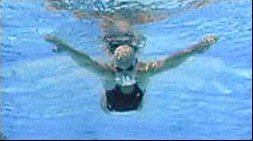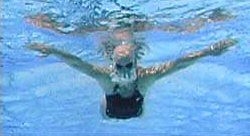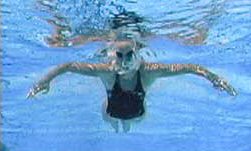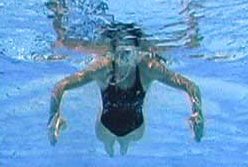4/01/05 BREASTSTROKE - How Wide To Pull?
Text and Photo/Video by Glenn Mills
Premium
Members - Click Here to Download Bonus Video Clip (Windows Media Player Format
875KB)
Premium
Members - Click Here to Download Bonus Video Clip (Quick Time Format 739KB)
When teaching breaststroke, or if youíre just learning the stroke, itís best to
start with a small, narrow pull. This helps you develop the correct rhythm and
timing for the stroke. In the learning stage, if you pull too hardÖor too
wideÖor too far back, itís difficult to get your arms back into streamline
before the start of the kick, and this throws off your timing.
Your initial focus in breaststroke should be on your timing and on the rhythm
of your body. Once you establish good rhythm, and once you progress beyond the
learning stage, then, over time, you can begin to experiment with a wider, more
powerful pull. Only when you have good rhythm and mature arm strength should
you begin to focus on the width of your pull. And even then, itís good to start
gradually and not overdo it. If you find that sending your hands wider makes it
harder to maintain your turnover or body rhythm, then youíre probably pulling
too wide, and too far back.
Many elite breaststrokers use a very wide pull, and we have chosen Staciana
Stitts to demonstrate this fact. Staciana, an Olympic Gold Medalist on the 400
Medley Relay in Sydney, is one of the best 100 breaststrokers in history, and
her success is due to many years of hard work.
Pulling as wide as Staciana will take strength and training. It takes time to
develop the power necessary to send your hands this wide AND to maintain your
rhythm.
Why Do It:
The big benefit of pulling wide, is that youíll be pulling more water to move
you forward. Also, the wider your arms, the more powerful levers you create to
help you draw the hips forward during the insweep. Wide arms help you connect
the movement of your arms to the motion of your hips and chest.
How To Do It;

|
1. Swim breaststroke as you normally would, setting
up a comfortable, consistent rhythm. When you first start to experiment with
the width of your pull, donít start out by swimming TOO fast. Just keep things
at a relaxed pace.
2. As you swim, keep looking toward the bottom of the pool as you send
your hands directly out toward the side walls. Keep your hands fairly HIGH, or
close to the surface.
|

|
3. Try not to PUSH your hands out but, rather,
use the momentum of your body to help SEND them out. You can see in the 2nd
picture that Stacianaís arms are pretty straight. If you try to get to this
position by PUSHING, it may feel powerful, but itís not very pro-ductive. Itís
better to use the press of the body to SEND the hands out.
|

|
4. Prior to allowing her elbows to pass her
shoulders, Staciana begins to turn the hands and sweep them down toward the
bottom. This is where the REAL acceleration begins in her pull. Itís here that
she begins to draw her hips forward, and allows her chest to rise to begin her
breath.
|

|
5. As her hands continue in, Staciana continues
to accelerate her hands and draw her hips forward. With the hands starting
wider, she is able to stay connected with the wa-ter through the entire process
of drawing the hips, and sending the chest and head up to air.
|
How To Do It Really Well (the Fine Points):
By watching the short video clip, youíll see that by sending the hands out
wider, Staci-ana is able to use her arms more effectively to bring her hips
forward quicker, which means sheís also setting up a more powerful kick.
Practice different widths for your pull. Make sure your coach is watching, and
make sure youíre not disturbing your rhythm. When you first try this, you may
feel that by pulling wider, you get ďcaughtĒ in the back of your stroke, and
itís harder to recover quickly. This is one reason to keep thinking about
keeping your hands high through the pull. Keep working on finding the perfect
balance between how wide, how rhythmic, and how powerful your pull is.